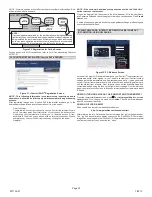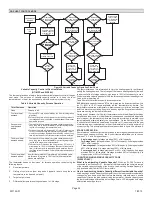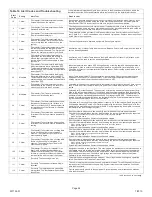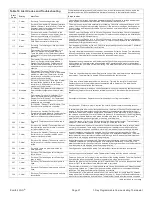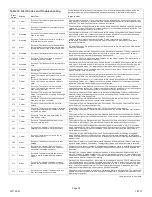
507152-01
7/2013
Page 24
GAS HEAT CONTROL MODE
NO
NO
YES
YES
YES
NO
NO
YES
YES
NO
NO
YES
YES
NO
YES
NO
Continue at
starting firing rate
T'stat
demand
satisfied
?
Starting firing rate
as determined by
variable capacity
algorithm (35 to
100%)
Differential
less than 2nd stage
differential
?
T'stat
demand
satisfied
?
T'stat
demand
satisfied
?
Firing rate
increased by
5% every 5
minutes up to
100% firing rate
Firing rate
increased by
5% every 5
minutes up to
100% firing rate
T'stat
demand sat-
isfied in less than
5 minutes
?
T'stat
demand sat-
isfied in less than
5 minutes
?
Increase firing rate
to calculated 2nd
stage firing rate
Increase firing rate
to calculated 3rd
stage firing rate
Increase firing
rate to 100%
until thermostat
demand is
satisfied
THERMOSTAT
DEMAND
SYSTEM
IDLE
YES
NO
Differential
less than 3rd stage
differential
?
YES
NO
Differential
less than 4th stage
differential
?
YES
NO
Differential
less than 2nd stage
differential
?
Differential
less than 2nd stage
differential
?
Differential
less than 3rd stage
differential
?
Differential
less than 4th stage
differential
?
Figure 38. Variable Capacity Operation Flow Chart
Variable Capacity Control of Gas Heat Mode
(G71MPP and SLP98V)
The thermostat includes a feature that provides variable capacity control of the gas
heat mode. The purpose of variable capacity control is to keep the room
temperature at, or near, the desired set point with minimum system cycling.
Table 9. Variable Capacity Furnace Operation
T'stat Demands
Operation
None
Furnace is off
First level heat
demand.
1. Furnace BTU rate is calculated by the iComfort integrating
algorithm.
2. Furnace firing rate will continue at current heating rate until
first stage demand is satisfied or an additional thermostat
demand is received.
Second level
heat demand
added
1. Thermostat will immediately increase variable capacity fur
nace firing rate to the calculated BTU percentage represent
ing the second stage thermostat demand.
2. Furnace firing rate will increase by 5% every 5 minutes (up
to 100% if second stage thermostat is not satisfied.) If ther
mostat second stage demand is satisfied the current firing
rate will continue until all thermostat demands are satisfied.
Third level heat
demand added.
1. Thermostat will immediately increase variable capacity fur
nace firing rate to the calculated BTU percentage represent
ing the third stage thermostat demand.
2. Thermostat will increase the firing rate by 5% every 5
minutes (up to 100% if third stage thermostat is not satis
fied.) If thermostat third stage demand is satisfied the cur
rent firing rate will continue until all thermostat demands are
satisfied.
Fourth level heat
demand added.
Icomfort thermostat will immediately set variable capa
city furnace firing rate to 100% until all thermostat de
mands are satisfied.
The thermostat bases its “decisions” for furnace operation control using the
following inputs:
Room temperature,
History of cycle times (how long does it typically take to bring the room
temperature to the desired set point),
Target set point, and
Differential temperature settings between 1st - 4th stage.
The thermostat uses this information to vary the heating capacity to efficiently
satisfy the heating demand. The full range of the furnace heating capacity (low end
is a percent of the 1st stage capacity; high range is 100% of full capacity) is used.
When in variable capacity gas heat mode, the furnace operation includes longer run
times at lower heat stages.
Table 9 details the variable capacity furnace operation.
SLP98
variable capacity furnaces BTUs firing rates can be incremented by as little
as 1% (35% to 100% range available) as the thermostat may dictate. The
thermostat monitors room temperature, previous heat cycle times, and target set
point to determine the starting firing rate, and any required firing rate increases or
decreases during the thermostat demand.
During a heat demand, the iComfort thermostat monitors the differential between
set point and room temp. As this differential increases and reaches field adjustable
levels (stages), the thermostat will increase firing rate accordingly to maintain room
temperature and ultimately satisfy the heat demand. On the next heat cycle, the
iComfort stat will calculate a new starting firing rate (in 1% increments) with the goal
of maintaining room temperature at, or near, thermostat set point with a minimum of
system cycling. The principles of operation are described in figure 38 and table 9.
STAGED OPERATION
Some furnaces can be configured to provide up to four stages of gas heat operation.
When staged heating is chosen, the iComfort thermostat allows you to choose
between 1, 2, 3 and 4 stages of heat.
Single-stage heat:
1st stage provides 100% of full capacity.
Two-stage heat:
1st stage provides 70% of full capacity; 2nd stage provides
100% of full capacity.
Three-stage heat:
1st stage provides 60% of full capacity; 2nd stage provides
80% of full capacity; 3rd stage provides 100% of full capacity.
Four-stage heat:
1st stage provides 35 or 40% of full capacity; 2nd stage
provides 60% of full capacity; 3rd stage provides 80% of full capacity; 4th
stage provides 100% of full capacity.
LOAD-TRACKING VARIABLE CAPACITY FAQS
(SLP98V ONLY)
What is Load-tracking Variable Capacity?
When an SLP98 Furnace is
connected to an iComfort Wi-Fi
thermostat
,
the thermostat takes complete charge
of the variable capacity staging of the furnace. Load
ï
tracking Variable Capacity is
only available with iComfort Wi-Fi thermostats.
How is Load-tracking Variable Capacity different from Variable Capacity?
Load-tracking Variable Capacity will smoothly track the load (sensible temperature
changes) up and down and adjust the furnace heating rate both ways. Variable
capacity only tracks the load upward (rising temperature). Variable capacity uses
the thermostats stage differentials but not stage timers. LVC disregards both stage
differentials and stage timers.











